 |
 |
 |
 |
 |
 |
2006 US Women's Open:
Battle By the Sea
Gallery 2 , Results
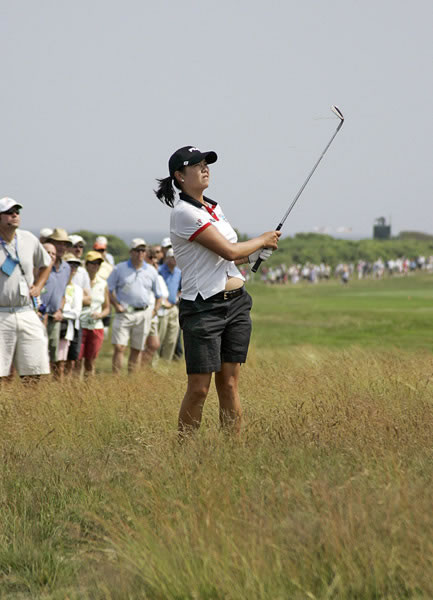 Among
the Koreans, several other players had good starts. Sung Ah Yim and Gloria
Park both shot 70 and were just a shot out of the lead. Michelle Wie also
put a 70 on the board in round one. Shi Hyun Ahn continued her great play
of late by shooting a 71; apparently the back troubles that had hampered
her in Rochester were not causing her difficulty now. Jee Young Lee also
shot an even par round; her long driving doubtless gave her a leg up on
the competition.
Among
the Koreans, several other players had good starts. Sung Ah Yim and Gloria
Park both shot 70 and were just a shot out of the lead. Michelle Wie also
put a 70 on the board in round one. Shi Hyun Ahn continued her great play
of late by shooting a 71; apparently the back troubles that had hampered
her in Rochester were not causing her difficulty now. Jee Young Lee also
shot an even par round; her long driving doubtless gave her a leg up on
the competition.
On the other hand, a bunch of top Koreans struggled on the first day. Perhaps no one had a more surprising bad time of it than Hee-Won Han. Han had been putting up one great finish after another all year; her only recent bad finish had come at the LPGA Championship, the year's previous Major. But on this day she never was able to get going and shot a woeful 6 over par 77. She followed that up with an even worse round on Saturday, an 80, to miss the cut by a mile. Seon Hwa Lee, Young Kim and Mi Hyun Kim all shot 4 over par rounds and found themselves tied for 53rd. Young Kim had been putting up great results in Majors for years, so her stumble was a particular surprise. Kimmie and Seon Hwa had both been very consistent all year, but neither is a long driver of the ball, and perhaps the conditions were too much for them.
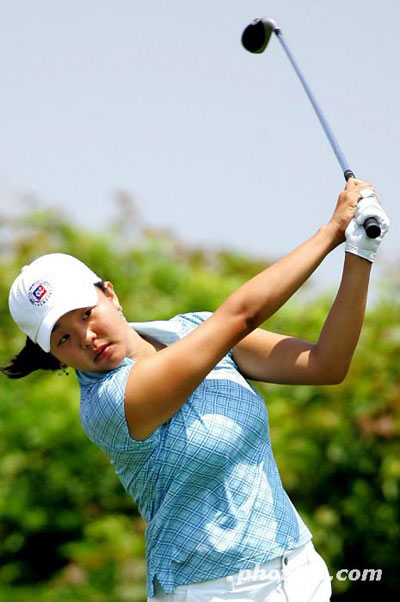 Early
in round two, Se Ri Pak made a birdie and moved to 3 under par, the solo
lead. But that didn't last; she made a bogey on the third hole to fall
back to 2 under. On this day she was still playing well tee to green:
her driving and greens in regulation were each only one worse than they
had been on day one. But her putting left more to be desired. Whereas
she had made only 29 putts on day one, on day two she made 33. Thus, instead
of an under par round, she put up a 3 over par 74. It was more than sufficient
for her to make the cut, and at one over for the event she was still very
much in it. But she would have to get back on track if she wanted to win.
Early
in round two, Se Ri Pak made a birdie and moved to 3 under par, the solo
lead. But that didn't last; she made a bogey on the third hole to fall
back to 2 under. On this day she was still playing well tee to green:
her driving and greens in regulation were each only one worse than they
had been on day one. But her putting left more to be desired. Whereas
she had made only 29 putts on day one, on day two she made 33. Thus, instead
of an under par round, she put up a 3 over par 74. It was more than sufficient
for her to make the cut, and at one over for the event she was still very
much in it. But she would have to get back on track if she wanted to win.
Jane Park (pictured), who started the day tied for the lead, also had her struggles on this day. She wound up shooting a two over par 73 which left her at even par. She was tied at that score with Michelle Wie and Shi Hyun Ahn. Ahn had managed two consecutive even par rounds.
Meanwhile, Young Kim rebounded nicely from her weak start with a 2 under par 69, the low score of the day. This moved her to 2 over par, still four shots out of the lead, but a lot closer to contention than she had been before. Jee Young Lee struggled, falling to four over, while Mi Hyun Kim shot a one over par round and was at 5 over par. They were still in decent position and might possibly make a run at the title. But Gloria and Sung Ah, both of whom had started the day just one shot out of the lead, were not so lucky. Gloria struggled to a 78 that knocked her all the way back to 6 over, while Yim shot a 79. Neither woman would contend again.
The leaders after round two were Annika Sorenstam and Pat Hurst. Annika
managed to shoot an even par round and thus remained at 2 under total.
Hurst shot an even par round as well. They had a two shot lead over the
three golfers at even par for the moment.
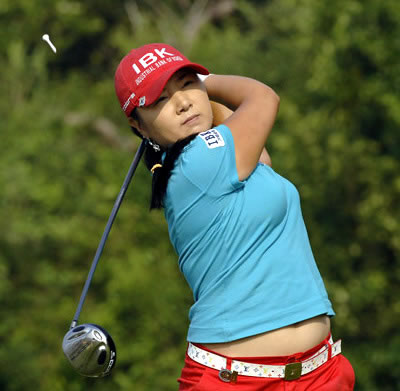 Sunday,
the marathon day of 36 holes, started early, and would continue on and
on until (hopefully) a winner was crowned. Se Ri found herself paired
with Paula Creamer, with whom she had been paired the first two rounds,
and Juli Inkster. A good pairing that was bound to help her stay focused.
The final group was Sorenstam, Hurst and Ahn, while Wie, Park and JJ were
in the next to last group. There was still a lot of golf to play, though,
and the winner might possibly come from way back.
Sunday,
the marathon day of 36 holes, started early, and would continue on and
on until (hopefully) a winner was crowned. Se Ri found herself paired
with Paula Creamer, with whom she had been paired the first two rounds,
and Juli Inkster. A good pairing that was bound to help her stay focused.
The final group was Sorenstam, Hurst and Ahn, while Wie, Park and JJ were
in the next to last group. There was still a lot of golf to play, though,
and the winner might possibly come from way back.
In the morning session, Se Ri lost more ground on the leaders. Much as had happened in round two, she was playing well tee to green but not making her putts. She made three bogies on the front nine to fall to 4 over. At that point the lead was coheld by Annika and Michelle Wie at 1 under, so while she was on the verge of dropping out of contention, she was still close enough if she could hold on. At that point, she worked hard to make par after par. She made a great par save from the bunker on 12, despite a very tough lie. A few minutes later, Sorenstam would miss a six foot par save on this very hole and fall to even par for the tournament. But Hurst had dunked a birdie on 11 to move to 1 under, so the lead had now changed: Hurst was the only player under par, while Annika, Inkster and Wie were all at even par.
After a few more holes, the lead changed again, with Inkster moving to
one under while Hurst fell back to even. But the player who was making
the biggest charge at this point in the round was none other than Jeong
Jang. JJ had struggled on the front nine, making three bogies and a birdie
before a double bogey on the treacherous ninth hole sent her back to +4
for the event and five shots out of the lead. She looked like she was
on a one way ticket to oblivion, but she rallied in a big way. On the
14th hole she drilled a fifteen foot birdie to move back to +3. She was
even more impressive on the next hole, where she dropped a 40 foot birdie
to move to 2 over. She then put her third shot on the par 5 16th to four
feet and made that birdie as well. Just like that, she had moved to 1
over par and was only two shots out of the lead with more than a whole
round yet to play.
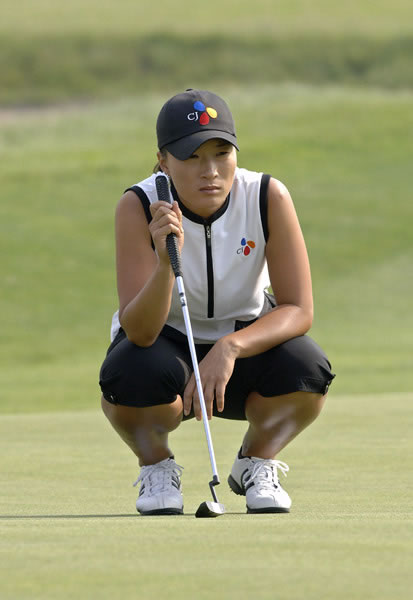 JJ
wasn't the only Korean rallying. Se Ri was trying to get something going
as well. After going 3 over par early in her round, she made a bunch of
pars to stay at 4 over. On 15, while her playing partner Inkster chipped
in to take the lead, Se Ri made bogey to fall to 5 over. But she made
that up with a birdie on the par 5 16th to return to 4 over. The par 3
17th, however, was playing tough, and though she hit her tee shot short
of the green, it bounced and rolled clear off the other side. She was
not able to get it up and down and fell again to 5 over. But on the lengthy
18th, she split the fairway with her drive and put her approach within
about 8 feet. She then drained the winding putt for a birdie to again
return to 4 over. She was fighting hard to stay in the tournament, and
it was working. But she had only one round left and a lot of ground yet
to make up.
JJ
wasn't the only Korean rallying. Se Ri was trying to get something going
as well. After going 3 over par early in her round, she made a bunch of
pars to stay at 4 over. On 15, while her playing partner Inkster chipped
in to take the lead, Se Ri made bogey to fall to 5 over. But she made
that up with a birdie on the par 5 16th to return to 4 over. The par 3
17th, however, was playing tough, and though she hit her tee shot short
of the green, it bounced and rolled clear off the other side. She was
not able to get it up and down and fell again to 5 over. But on the lengthy
18th, she split the fairway with her drive and put her approach within
about 8 feet. She then drained the winding putt for a birdie to again
return to 4 over. She was fighting hard to stay in the tournament, and
it was working. But she had only one round left and a lot of ground yet
to make up.
Her playing partner Inkster looked poised to break from the rest of the
field, but the last two holes were a major setback for her. On 17, she
put her tee shot in the bunker in an almost impossible lie. She hit it
over the flag but could not make the fifteen foot par save, and thus fell
to even par. On 18 she hit her drive into the rough and had to punch out;
she made bogey there, too. In just two holes she had fallen to one over
par, still in it, but no longer with the advantage.
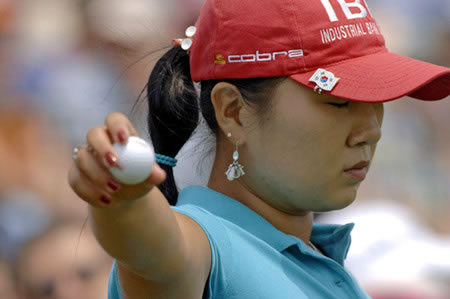 JJ
had her own struggles on these final two holes. On 17 she put her tee
shot in the same spot Inkster had put hers. She hit a great shot out from
there, but her ball did not roll back towards the flag, perching on the
slope dangerously. She had to be very careful not to accidentally move
it when preparing her par putt. She barely tapped it, but missed and bogied
to fall to 2 over. On 18, she hit her drive into some tall weeds. It was
here she had arguably the most controversial moment of her entire career.
She took a stout whack at the ball and got it out of the tall stuff. But
the ball took a strange detour in the middle of its path. On replay, it
looked for all the world like JJ had hit the ball twice in one swing.
That would count as two strokes. She would go on to make a double bogey
after hitting her third shot over the green. But the question remained:
did she hit it twice? She did not believe she had, but the USGA officials
felt more review was necessary. So after her round, she spent several
minutes in a trailer while they showed her the video replay of the shot
over and over. No matter how often she saw it, she remained convinced
she had not double hit the shot. The USGA decided she should not be penalized,
especially since an official at the site where it happened did not see
it, either. Thus, JJ signed for her score without the penalty and began
her fourth round. But after more deliberation and many calls from fans
watching the coverage, the USGA decided to change their decision and added
the penalty to her score. They told her about this on the 5th tee of the
final round. By this point she had been thoroughly shaken up by the incident
and was already starting to make bogies. The news of the penalty completely
unhinged her, and she went on to shoot an 80 in the round. It was a really
unfortunate end to what had been, up until then, a great tournament for
her .
JJ
had her own struggles on these final two holes. On 17 she put her tee
shot in the same spot Inkster had put hers. She hit a great shot out from
there, but her ball did not roll back towards the flag, perching on the
slope dangerously. She had to be very careful not to accidentally move
it when preparing her par putt. She barely tapped it, but missed and bogied
to fall to 2 over. On 18, she hit her drive into some tall weeds. It was
here she had arguably the most controversial moment of her entire career.
She took a stout whack at the ball and got it out of the tall stuff. But
the ball took a strange detour in the middle of its path. On replay, it
looked for all the world like JJ had hit the ball twice in one swing.
That would count as two strokes. She would go on to make a double bogey
after hitting her third shot over the green. But the question remained:
did she hit it twice? She did not believe she had, but the USGA officials
felt more review was necessary. So after her round, she spent several
minutes in a trailer while they showed her the video replay of the shot
over and over. No matter how often she saw it, she remained convinced
she had not double hit the shot. The USGA decided she should not be penalized,
especially since an official at the site where it happened did not see
it, either. Thus, JJ signed for her score without the penalty and began
her fourth round. But after more deliberation and many calls from fans
watching the coverage, the USGA decided to change their decision and added
the penalty to her score. They told her about this on the 5th tee of the
final round. By this point she had been thoroughly shaken up by the incident
and was already starting to make bogies. The news of the penalty completely
unhinged her, and she went on to shoot an 80 in the round. It was a really
unfortunate end to what had been, up until then, a great tournament for
her .
But three controversies remain. One, did she in fact double hit the ball? Two, did she know she did it but lied, and three, should the USGA have assessed the penalty despite her assertion she was innocent?
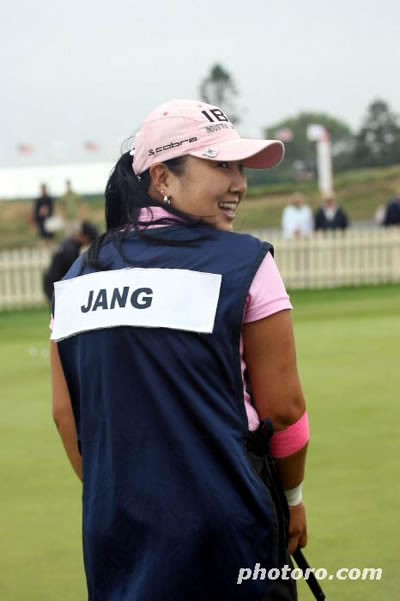 As
to the first question, NBC showed the shot over and over on their broadcast.
There was no doubt that the ball, which was buried in very deep rough,
changed direction noticeably after JJ hit it initially. The way her club
was cutting through the grass, it looked quite possible that it hit the
ball a second time and changed its course. But it also looked possible
that the ball was impacted by a huge clump of grass JJ dislodged on her
swing. And the hill was steep enough that it was even possible it hit
the hill and bounced off a rock or something under the grass. The video
was not clear enough to be 100% sure. A double hit was the most likely
explanation, but not the only one.
As
to the first question, NBC showed the shot over and over on their broadcast.
There was no doubt that the ball, which was buried in very deep rough,
changed direction noticeably after JJ hit it initially. The way her club
was cutting through the grass, it looked quite possible that it hit the
ball a second time and changed its course. But it also looked possible
that the ball was impacted by a huge clump of grass JJ dislodged on her
swing. And the hill was steep enough that it was even possible it hit
the hill and bounced off a rock or something under the grass. The video
was not clear enough to be 100% sure. A double hit was the most likely
explanation, but not the only one.
Even if JJ did double hit the ball, it was likely that the impact was blunted by the ton of sod she dug up during her swing. That grass and dirt might have made it tough for her to tell if she had hit the ball twice (and again, it's not even clear that she did). In any event, even after being shown the video, she was adamant that she did not believe she double hit. Was she telling the truth? Well, only Jang can know for sure, but let's look at the record. This is a person with a heart as big as all outdoors. Just the previous week came the touching story of how, following her victory, she went to a memorial for American veterans of the Korean War and donated money to their veterans group. There have been many other stories of her being kind to fans, such as the time she gave a young fan one of her club covers. All these stories do not jibe with the idea of her knowingly cheating just to save a single shot. And the USGA even gave her an out, which she refused to take. She maintained until the end that she did not believe she had double hit. Knowing her personal integrity, I for one believe her. It's a pity that many fans on message boards have taken to branding her a cheater when this is doubtless the only information they have about this talented and wonderful young golfer.
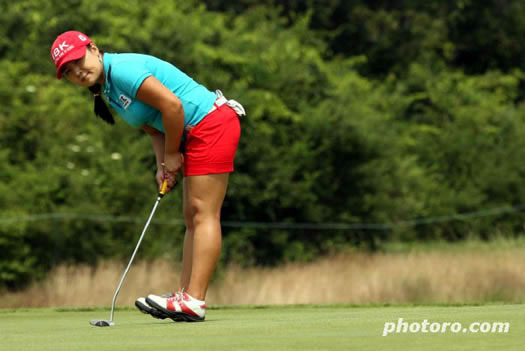 So
did the USGA do the right thing? One of the commentators on the Golf Channel
later said that they 'saved her from herself', whatever that means (he
said it as though the viewer would understand him, but what in fact is
she being saved from? Peer scorn? Possible DQ later (which can't happen)?
His statement was nonsensical). The USGA argued that they had to protect
the field from a possible infraction. While they never said she was purposely
trying to cheat, they felt that, after reviewing the evidence, it clearly
was a double hit and the penalty had to be assessed. They did not DQ her,
however, because they had already OKed her score card after round 3 in
order to get her fourth round started on time. Under normal conditions,
they would not have let her sign the card until the issue had been resolved.
So
did the USGA do the right thing? One of the commentators on the Golf Channel
later said that they 'saved her from herself', whatever that means (he
said it as though the viewer would understand him, but what in fact is
she being saved from? Peer scorn? Possible DQ later (which can't happen)?
His statement was nonsensical). The USGA argued that they had to protect
the field from a possible infraction. While they never said she was purposely
trying to cheat, they felt that, after reviewing the evidence, it clearly
was a double hit and the penalty had to be assessed. They did not DQ her,
however, because they had already OKed her score card after round 3 in
order to get her fourth round started on time. Under normal conditions,
they would not have let her sign the card until the issue had been resolved.